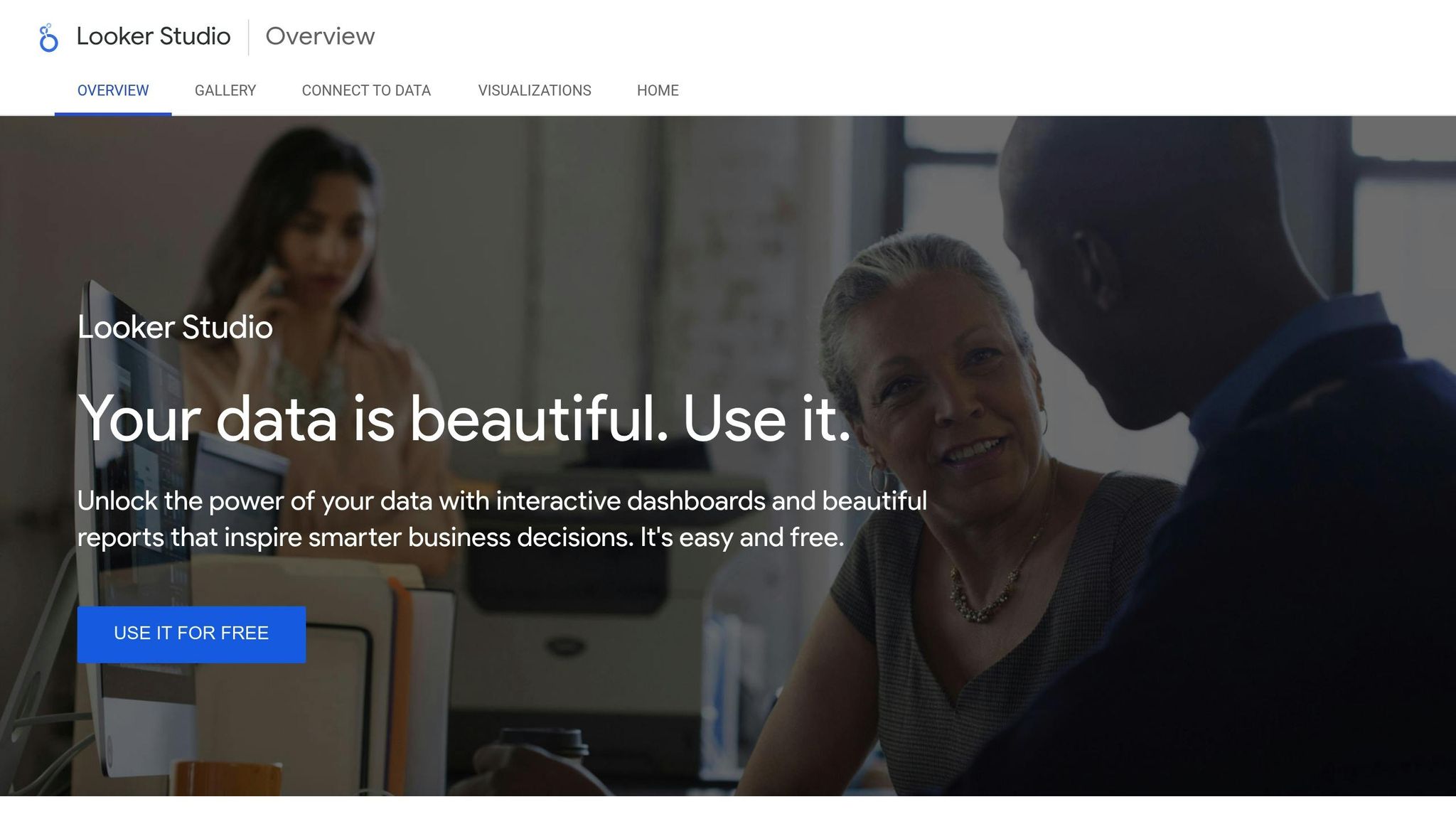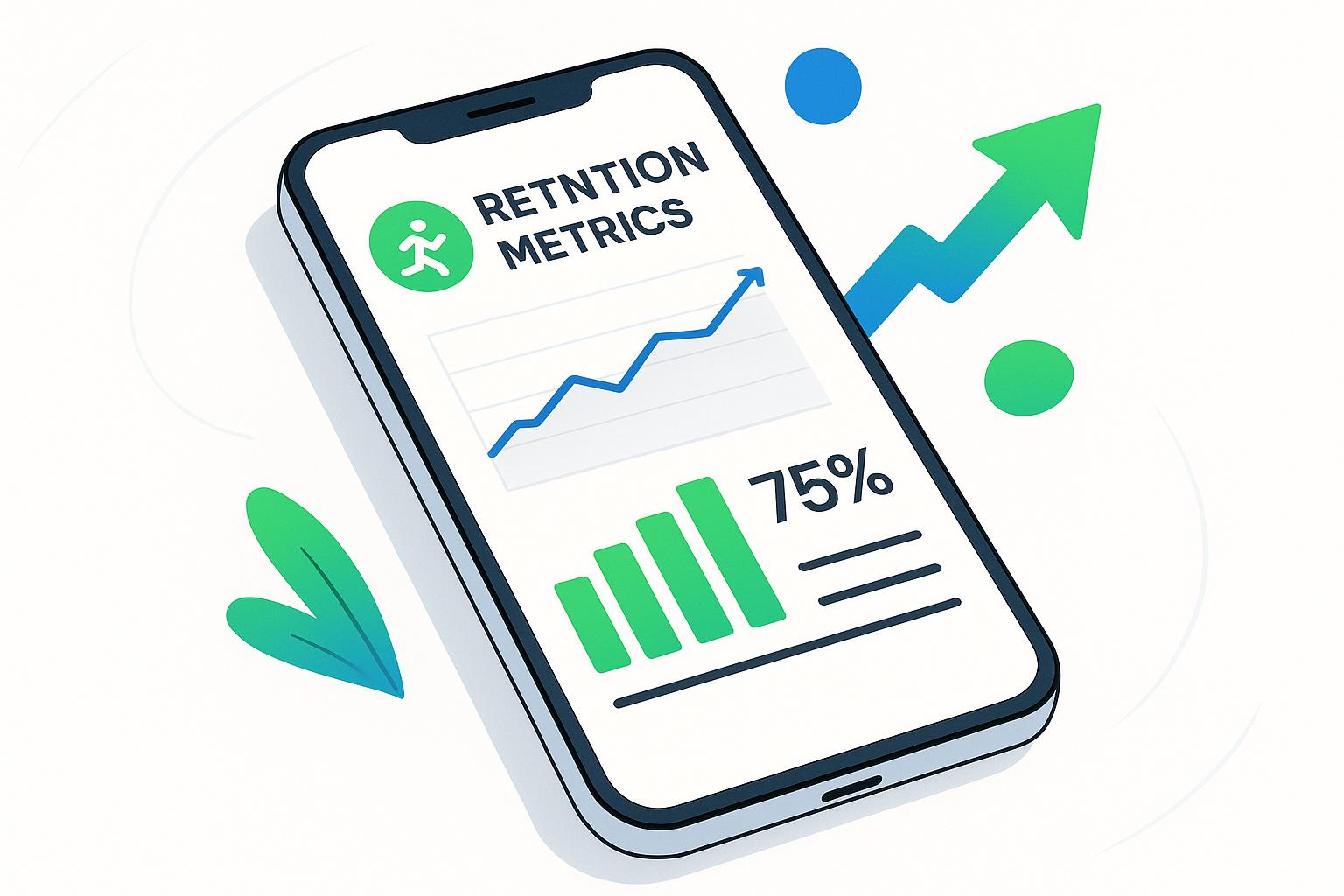Interactive financial dashboards are transforming how businesses analyze and act on data. Unlike static spreadsheets, these dashboards provide real-time insights through visual tools like charts, drill-downs, and filters. They save time, reduce errors, and improve decision-making by connecting directly to accounting systems, ERPs, and CRMs. Companies using them report faster reporting cycles, fewer errors, and measurable performance improvements like increased revenue and reduced operational costs.
Key Steps to Building a Dashboard:
- Define Goals and Metrics: Identify stakeholder priorities and focus on 8–12 critical KPIs like cash flow, burn rate, or MRR growth.
- Prepare Data: Centralize data sources, remove duplicates, fill gaps, and standardize formats for accuracy.
- Choose Visualizations: Use bar charts, line charts, and heat maps for clarity. Avoid clutter with simple, focused layouts.
- Add Interactive Features: Enable drill-downs, filtering, and real-time updates to make dashboards more actionable.
- Optimize for Board Use: Highlight key insights with clear formatting, annotations, and U.S.-standard conventions.
Why This Matters:
Interactive dashboards simplify complex financial data, turning it into actionable insights. They help stakeholders quickly understand performance and make informed decisions, whether in daily operations or board meetings. Tools like Lucid Financials streamline the process by integrating data and automating updates.
By following these steps, you can create dashboards that are easy to use and provide meaningful insights tailored to your business needs.
Step-by-Step: Building a Looker Studio Dashboard for CFOs (Tutorial with Example!)

Step 1: Define Goals and Key Metrics
To create a financial dashboard that delivers real value, you need to start by identifying what matters most to your stakeholders. Their priorities will shape the metrics and insights your dashboard provides.
Understand Board and Stakeholder Priorities
Your board members and stakeholders are the main audience for your financial dashboard, so their input is crucial. Early collaboration helps you capture the metrics that matter most to them. Start by conducting quick interviews with key decision-makers to understand their biggest concerns and goals.
- Board members often focus on strategic, high-level metrics like cash flow, burn rate, and runway. These metrics reveal the company’s ability to grow and deliver returns.
- Investors tend to care about customer acquisition efficiency and retention - key indicators of long-term profitability.
- Executives usually need operational insights to guide daily decisions.
To cater to different time constraints, consider offering multiple views of the dashboard. For instance, a concise executive summary can provide a high-level snapshot for quick reviews, while detailed drill-downs can give finance teams the depth they need for analysis.
Once you’ve gathered these insights, translate them into specific, measurable metrics that align with these priorities.
Select Relevant Financial Metrics
The metrics you choose should align with the priorities you’ve identified and match your company’s stage and goals. For example, startups might focus on cash flow, burn rate, and runway metrics to monitor financial health and sustainability.
For SaaS companies, some key metrics to track include:
- LTV:CAC ratio: Aim for at least 3:1, with 5:1 being ideal.
- MRR growth: Target monthly growth of 10–15%.
- Burn rate: Keep monthly burn between $10,000 and $15,000.
- Churn rate: Strive for less than 5% monthly churn, with less than 2% being optimal.
- Gross margins: Maintain margins between 40–60%.
- Customer lifetime: Aim for a lifetime of 36–48 months.
To keep the dashboard effective and user-friendly, limit it to 8–12 key performance indicators (KPIs). A streamlined design ensures that top-level insights are immediately visible, while additional details can be accessed through drill-down features. This approach is critical because cluttered dashboards often lead to low adoption rates - only about 25% of users actively engage with modern analytics tools when dashboards are too complex.
Step 2: Collect and Prepare Financial Data
Now that you've outlined your key metrics, it’s time to gather and organize the financial data that will power your dashboard. This step requires a sharp focus on data sources and quality to ensure your dashboard delivers accurate and reliable insights.
Organize Data Sources
Financial data often lives in multiple systems - accounting software, banking platforms, payment processors, payroll systems, and CRMs. To avoid delays and errors from manual entry, centralize these sources into one streamlined system.
Start by mapping out all your data sources. Many businesses, especially growing ones, rely on several disconnected systems that don’t automatically share data. Real-time integration can solve this issue, eliminating the need for manual exports and reducing errors. Platforms like Lucid Financials excel here, integrating directly with multiple data sources to provide reconciled books in just seven days and maintaining real-time updates. This ensures your dashboard always reflects your current financial position.
When centralizing, focus on systems that update frequently. Your accounting software should be your primary source of truth, but it must be fed by real-time data from sources like payment processors and bank feeds. This creates a steady flow of information rather than relying on periodic snapshots.
Pay attention to how often each source updates. For example, bank transactions might update daily, while payroll data might only change bi-weekly or monthly. Your dashboard should be flexible enough to handle these varying cycles while still delivering timely insights.
Once your sources are centralized, shift your focus to ensuring the quality of your data by cleaning and standardizing it.
Clean and Standardize Data
Raw data is rarely ready for dashboards. Clean, well-organized data is the backbone of reliable insights. Before diving into visualizations, address issues like inconsistencies, duplicates, and formatting errors that could skew your metrics or mislead stakeholders.
Start by removing duplicates, especially when combining multiple sources. For instance, a single transaction might appear in both your bank feed and payment processor data, inflating revenue figures and potentially leading to poor decisions. Deduplicating this data ensures accuracy.
Next, address missing values. Instead of ignoring gaps, establish rules for filling them. For example, if marketing spend data is missing for certain periods, your customer acquisition cost (CAC) calculations could be understated. Use historical averages, direct data entry, or system integrations to fill in these gaps and ensure completeness moving forward.
Standardization is equally important. Use consistent date formats like MM/DD/YYYY, apply proper currency formatting (e.g., $1,234,567.89), and align all categories with your master chart of accounts. Different systems might label the same expense in various ways - like calling software subscriptions “Technology,” “Software,” or “SaaS Tools.” By mapping all data to standardized categories, you’ll maintain consistency and clarity across reporting periods.
Finally, validate your data by cross-referencing key metrics. For example, your monthly recurring revenue from your CRM should match the revenue recognized in your accounting system. Discrepancies often point to integration issues or timing differences that need to be resolved before launching your dashboard. Set up automated checks to flag when metrics from different sources diverge beyond acceptable limits.
Investing time in proper data preparation ensures that your dashboard delivers trustworthy insights. With clean, standardized data, stakeholders can confidently drill down into metrics, knowing the information is consistent and reliable for decision-making.
Step 3: Build the Dashboard Framework
With your data cleaned and organized, it’s time to transform those numbers into a dashboard that delivers clear, actionable insights. The framework you create will determine whether your dashboard becomes a vital decision-making tool or just another confusing collection of data. Focus on using visualization methods that make insights instantly clear and arrange your layout to guide stakeholders smoothly through your financial story.
Choose the Right Visualization Tools
Different types of financial data call for different visualization techniques. Here’s a breakdown of what works best:
- Bar charts: Perfect for comparing values like quarterly revenue across departments or monthly expenses by category. They make it easy to see which areas are performing well or where costs are rising. For longer category names, such as "Professional Services and Consulting Fees", horizontal bar charts work best.
- Line charts: Excellent for showing trends over time. Use them to track metrics like monthly recurring revenue (MRR), cash runway, or customer acquisition costs. Adding multiple lines to the same chart can highlight relationships, like comparing revenue growth with customer acquisition costs to evaluate sustainability.
- Heat maps: Great for spotting patterns and outliers across multiple dimensions. For example, a heat map of monthly expenses can quickly highlight unusual spikes, while a customer cohort heat map can reveal which acquisition channels generate the highest lifetime value. The varying intensity of colors makes these patterns clear, even for non-financial experts.
- Gauge charts: Best for single metrics with clear targets, such as burn rate versus runway. However, use them sparingly to avoid clutter.
- Waterfall charts: These are ideal for breaking down how individual components contribute to a total change. For example, you can use them to show how new sales, expansions, churn, and other factors affect overall revenue shifts.
Avoid using pie charts for financial data - they often lack clarity. Instead, opt for horizontal bar charts when dealing with multiple categories.
Once you’ve chosen the right visualizations, the next step is to design a layout that tells your financial story clearly and logically.
Design a Focused Layout
Your dashboard should do more than just display data - it should narrate your company’s financial journey in a way that’s easy to follow. A well-structured layout ensures stakeholders can quickly grasp the most important insights.
- Start with key metrics. Place critical information, like cash position and burn rate, in the top-left corner. This is where viewers naturally look first, especially on devices like laptops or conference room screens. This section should immediately answer the question, “How is the business doing right now?”
- Group related metrics. Don’t scatter similar data points across the dashboard. Instead, create sections for revenue, expenses, cash flow, and key performance indicators (KPIs). Use whitespace or subtle borders to separate these sections and keep the layout clean.
- Highlight what matters most. Important charts, like one showing cash runway, should be larger and more prominent. Don’t tuck critical metrics into a corner where they might get overlooked.
- Use consistent colors. Assign specific meanings to colors and stick with them. For instance, green for positive trends like revenue growth, red for warning signs like rising burn rates, and neutral tones like blue or gray for supporting data. Consistent color usage helps reinforce the story your dashboard is telling.
- Think about your audience. Board members often want a high-level overview first, with the option to dig into details. Arrange your dashboard to follow this top-down approach, placing summary metrics at the top and more detailed breakdowns further down.
- Optimize for screen sizes. Whether it’s a laptop or a large conference display, test your dashboard on different devices to ensure everything is easy to read. Don’t try to cram everything into one view - allow for scrolling through well-organized sections if needed.
- Keep formatting uniform. Display currency as $1,234,567.89, use MM/DD/YYYY for dates, and show percentages with consistent decimal precision. This consistency reduces confusion and makes the data easier to interpret.
- Make titles specific. Instead of vague labels like "Revenue" or "Expenses", use titles that clearly describe the content, such as "Monthly Recurring Revenue – 12 Month Trend."
For those using tools like Lucid Financials, integrating customizable dashboard elements with a strong data infrastructure can simplify the process of creating dashboards that deliver clear and actionable insights.
The ultimate goal? A dashboard that tells your financial story intuitively, allowing stakeholders to understand overall performance in seconds and dive deeper into the details as needed.
sbb-itb-17e8ec9
Step 4: Add Interactive Features
Static dashboards are great for showing past performance, but interactive dashboards take it a step further. They let stakeholders dig into the data to uncover root causes and spot trends for the future. By incorporating interactivity, your financial dashboard becomes more than just a reporting tool - it turns into a decision-making powerhouse. Let’s look at how you can boost interactivity using drill-down and filtering tools.
Add Drill-Down and Filtering Features
Drill-down features let users click on a high-level metric to access more detailed, filtered data views. To set this up, map out the data hierarchy so each click reveals the next level of detail. This involves preparing the necessary fields and relationships, designing both high-level and detailed visualizations, and linking them through filters or parameters.
Enable Real-Time Updates and Notifications
Step 5: Best Practices for Board-Ready Dashboards
Creating a board-ready dashboard means presenting clear, actionable visuals that help board members make quick, informed decisions. The difference between a decent dashboard and one designed for a boardroom lies in the details - everything from the metrics you highlight to the way you format the data matters.
Focus on Actionable Insights
Board members don’t have time to sift through unnecessary data. Your dashboard should focus on critical metrics like cash runway, MRR growth, CAC, and burn rate. The goal? Make key insights pop within five seconds of viewing.
To achieve this, keep the design simple and use a clear visual hierarchy. Place the most important metrics at the top, with supporting data below. Avoid cluttering the dashboard with too much information - less is more when it comes to decision-making tools.
Color coding is another powerful tool. Stick to a consistent system:
- Red for urgent issues
- Yellow for areas requiring caution
- Green for positive trends
Be cautious with red - reserve it exclusively for urgent matters to avoid unnecessary alarm.
Adding annotations to charts can make a big difference. For example, if revenue drops 15% month-over-month, include a brief note explaining whether it was due to seasonal trends, a delayed payment, or another specific factor. These short explanations help board members quickly understand not just what happened, but why it happened.
Lastly, give your data context by benchmarking it against industry standards or your company’s historical performance. This comparison helps raw numbers tell a more meaningful story.
Use Localization for U.S. Formats
Clarity isn’t just about the data - it’s also about how it’s presented. Using consistent, localized formats not only boosts credibility but also ensures that board members can interpret the information without confusion. Stick to U.S. conventions to streamline communication.
Here’s what that looks like:
- Currency: Always display figures in U.S. dollars with a dollar sign ($) and commas for thousands. For example, write "$1,250,000" rather than "1250000" or "1.25M."
- Dates: Use the MM/DD/YYYY format. For instance, "03/15/2024" is far easier for U.S. audiences to interpret than "15/03/2024" or "2024-03-15."
- Numbers: Add commas for thousands and use periods for decimals. For example, "2,847,392" and "15.7%" are clear and familiar to U.S. readers.
- Measurements: Use imperial units - miles, pounds, and feet instead of kilometers, kilograms, or meters.
- Temperature: Display Fahrenheit, not Celsius.
- Time Zones: Standardize timestamps to a single time zone, ideally Eastern Time (ET), if that’s when meetings typically occur. This avoids any confusion about scheduling.
Tools like Lucid Financials can automatically apply these U.S. formatting standards, saving you time and ensuring consistency. By paying attention to these localization details, you present a polished, professional dashboard that allows board members to focus on insights instead of deciphering unfamiliar formats.
Conclusion: Improve Financial Clarity with Interactive Dashboards
Creating interactive financial dashboards can transform how you communicate with your board and make decisions. By following a clear process, you can turn raw financial data into actionable insights that everyone can quickly understand.
The real power of these dashboards lies in their ability to simplify complex information. Instead of spending valuable meeting time deciphering spreadsheets, you can present clear visuals that highlight critical metrics like cash runway, revenue growth, burn rate, and key KPIs. This approach allows board members to immediately grasp your financial position and focus on strategic discussions rather than getting bogged down in data interpretation.
Features like interactive drill-downs and real-time updates add another layer of effectiveness. They let you filter data instantly and provide context for any revenue drop or unexpected expense. This level of readiness not only saves time but also showcases your deep understanding of the business, building trust and confidence among stakeholders.
Consistency in formatting is another key aspect. Using familiar U.S. conventions like dollar signs, MM/DD/YYYY dates, and standard number formats ensures that your board can focus entirely on the insights rather than struggling with unfamiliar layouts or styles.
For startups and fast-growing companies, tools like Lucid Financials make this process even easier. With AI-powered bookkeeping, they deliver clean financial records in just seven days and provide always-on, investor-ready reports. These real-time insights ensure you're prepared for those crucial conversations with investors and stakeholders.
As your business grows, your dashboard should grow with it. Start with the basics, focusing on the most critical metrics, and gradually add more features as your team becomes comfortable with the tool. By investing in interactive dashboards, you’ll not only speed up decision-making but also foster more engaging and productive board discussions. These steps will ensure your dashboard remains a valuable asset for driving sharper strategies and quicker decisions.
FAQs
What makes interactive financial dashboards better than static spreadsheets?
Interactive financial dashboards bring a range of benefits that go beyond what traditional static spreadsheets can offer. They let you work with data in real time, dig deeper into specific details, and spot trends or patterns much quicker. This dynamic way of handling data helps you stay responsive to changing business demands and make smarter decisions.
These dashboards are also incredibly flexible and easy to use, which makes teamwork smoother. They present financial data in a visual and actionable format, making it easier for teams to collaborate and understand the numbers. By turning complex financial details into clear, engaging visuals, they enhance clarity and streamline discussions - especially during important moments like board meetings.
How can businesses ensure their financial dashboards provide accurate and reliable data?
To make sure your financial dashboards deliver accurate and trustworthy insights, begin by automating both data validation and reconciliation tasks. This not only saves time but also minimizes errors. Regular audits and well-defined data governance policies are equally important to uphold data integrity. Keep a close eye on critical metrics such as accuracy, completeness, and timeliness to quickly spot and resolve any issues.
Getting stakeholders involved early in the process can help align expectations and build confidence in the dashboards. Additionally, using advanced tools for monitoring data quality ensures ongoing reliability. By focusing on these practices, you can create dashboards that empower smarter decision-making and provide solid support for key discussions, like those in board meetings.
What are the best practices for designing financial dashboards that clearly communicate insights to board members?
When creating financial dashboards that deliver clear insights, start by identifying the key questions your dashboard needs to address. Tailor the content to your audience by focusing on the most relevant data, such as overarching trends, essential KPIs, and projections. Use visual hierarchy to direct attention effectively, featuring charts and graphs like bar charts, trend lines, and pie charts to simplify complex information.
Add annotations or explanatory notes to call out important insights or shifts in data, making it easier for stakeholders to understand the narrative behind the numbers. Maintain a clean, uncluttered design by using consistent formatting, a cohesive color palette, and clear labels to enhance readability. These steps ensure your dashboard supports meaningful, strategic discussions in board meetings by providing clarity and actionable takeaways.


